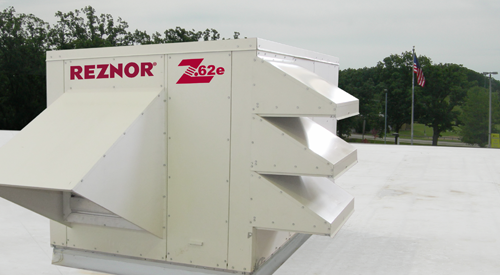The Reznor Models XAWS, XAWU, XBWS and XBWU Energy Recovery Systems
Energy recovery COMPONENT certified to the ARI Air-to-Air Energy Recovery Ventilation
Equipment Certification Program in accordance with ARI Standard 1060-2000. Energy recovery
wheel listed in the ARI 1060 Directory of Certified Air-to-Air Energy Recovery Ventilation
Equipment. Actual performance in packaged equipment may vary
Applications:
Energy recovery systems can be used alone or with other hvac equipment to recover exhaust air energy and reintroduce it into the conditioned space. The energy recovery wheel provides sensible and latent energy exchange between the entering and exhaust air streams of a building. This allows a substantial amount of the energy which is normally lost in the exhaust air stream to be returned into the entering air. Ideal applications are areas that have cold or hot temperatures with high occupancy loads or high ventilation requirements. Areas that have high humidity or very low humidity (recover exhaust humidity air from buildings that have humidifiers) are good applications. Energy recovery units also reduce the design loads due to outside air, which can mean downsizing the air conditioning equipment. Application software is available to calculate the load reductions and provide the energy and dollar savings for all areas of the United States and Canada.
Principle of Operation:
The energy recovery enthalpy wheel contains parallel layers of a polymeric material that are impregnated with silica gel (desiccant). The wheel is located in the entering (intake) air and exhaust air streams of the ventilation equipment. As the wheel rotates through each air stream, the
wheel surface captures sensible and latent energy. In the heating mode, the wheel rotates to provide a constant transfer of heat from the exhaust air stream to the colder intake air stream. During the cooling season, the process is reversed.
During periods when the outside air is cool and energy recovery is not desired, the Stop-Start-Jog option is utilized to stop the wheel from turning, thereby providing cool outside air into the space.
• Reduces cooling load at design temperatures up to 4 tons per 1000 cfm of outside air.
• Reduces heating load up to 12,000 BTUH per 400 cfm of outside air.
• Dry energy transfer. Moisture in supply (intake) air stream is transferred to exhaust air stream in a vapor state, eliminating condensate plumbing in the ventilator.
• Separate fused power supply.
• Filters / mist eliminators are provided on the entering air openings of the outdoor units.
• Centrifugal blowers (both intake and exhaust) for high static capability and low sound levels.
• Heavy gauge galvanized steel cabinets.
• Fully insulated cabinet.
• ARI rated internal enthalpy wheel is provided.
• Internal enthalpy wheel made of polymeric material with silica gel impregnated into the material. The enthalpy wheel has a five year limited warranty.
• Internal enthalpy wheels are easily cleanable. Large wheels (36 inch diameter and above) are segmented into easily removable sections.
• All wheels are designed to easily slide in and out for easy servicing.
• Continuous operation down to 10°F (-12°C) without defrost at indoor relative humidity up to 40%. For temperatures below 10°F (-12°C), Optional Low Ambient Control Kit is required. Kit includes
temperature sensor to shutoff power to unit before frost build up can occur on recovery wheel.
Model Description:
XAWS – Indoor, Stand Alone Energy Recovery Unit in Side by Side design.
XAWU – Indoor, Stand Alone Energy Recovery Unit in Over/Under design.
XBWS – with AQ20 Rooftop, Stand Alone Energy Recovery Unit in Side by Side design with horizontal air duct arrangement.
XBWS – with AQ21 Rooftop, Stand Alone Energy Recovery Unit in Side by Side design with vertical (down) return and supply air duct arrangement.
XBWU – Rooftop, Stand Alone Energy Recovery Unit in Over/Under design. Horizontal discharge.


